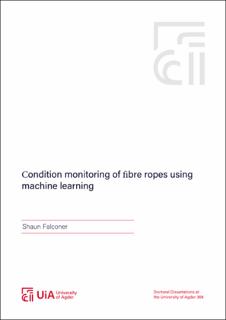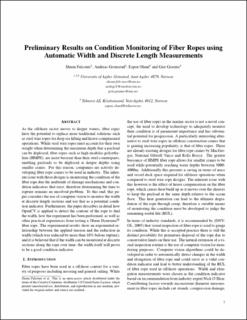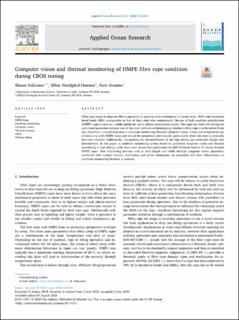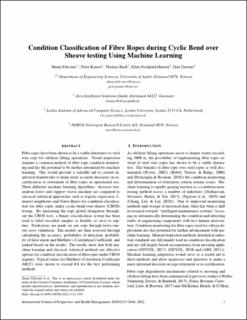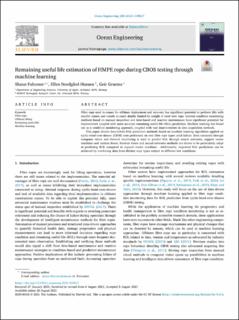| dc.contributor.advisor | Grasmo, Geir | |
| dc.contributor.advisor | Nordgård-Hansen, Ellen Marie | |
| dc.contributor.author | Falconer, Shaun | |
| dc.date.accessioned | 2022-06-13T10:14:12Z | |
| dc.date.available | 2022-06-13T10:14:12Z | |
| dc.date.issued | 2022 | |
| dc.identifier.citation | Falconer, S. (2022). Condition monitoring of fibre ropes using machine learning [PhD. thesis]. University of Agder. | en_US |
| dc.identifier.isbn | 978-82-8427-078-4 | |
| dc.identifier.issn | 1504-9272 | |
| dc.identifier.uri | https://hdl.handle.net/11250/2998488 | |
| dc.description.abstract | The application of fibre ropes in offshore lifting operations has significant potential for further development. With minimum breaking loads (MBL) equivalent to steel wire at similar diameters and almost neutral buoyancy in water, it is in theory possible to reach depths exceeding 3000 m with smaller cranes and vessels, representing substantial savings in not only potential operation costs. However, with fibre ropes there are different requirements and standards to consider with regards to condition monitoring, maintenance and retirement criteria.
Safe and reliable operations are paramount in the offshore sector and any incidents that occur during offshore lifting would not be only significantly damaging financially but could potentially lead to loss of life. Current standards for fibre rope condition monitoring originate in mooring applications, and are based on manual inspection for retirement and re-certification. There is significant room for developments in methods that can aid the inspection process.
To address this problem, computer vision and thermal monitoring methods for fibre ropes are developed and experimentally investigated at the Mechatronics Innovation Lab in Grimstad, Norway. The methods are used to monitor changes in fibre rope condition during cyclic-bend-over-sheave testing and to find relevant condition indicators that give more information regarding the condition and remaining useful life of the fibre rope. In addition, the data recorded is used to form machine learning models that both classify rope condition and predict the remaining life of fibre ropes during CBOS testing. The expected outcome is to use physics-based machine learning methods to improve both condition classification and remaining useful life estimation of bre ropes used in offshore lifting operations.
In the appended papers at the end of this thesis, the proposed methods have been experimentally investigated and validated through cyclic-bend-over-sheave experiments performed at the Mechatronics Innovation Lab and further data analysis performed at the University of Agder, Norway and at divis in Dortmund, Germany. | en_US |
| dc.language.iso | eng | en_US |
| dc.publisher | University of Agder | en_US |
| dc.relation.ispartofseries | Doctoral Dissertations at the University of Agder; no. 368 | |
| dc.relation.haspart | Paper I: Falconer, S., Gromsrud, A., Oland, E., & Grasmo, G. (2017). Preliminary Results on Condition Monitoring of Fiber Ropes using AutomaticWidth and Discrete Length Measurements. Annual Conference of the PHM Society, 9(1). https://doi.org/10.36001/phmconf.2017.v9i1.2478. Accepted manuscript. Full-text is available in AURA as a separate file: . | en_US |
| dc.relation.haspart | Paper II: Falconer, S., Grasmo, G. & Nordgård-Hansen, E. Condition monitoring of HMPE bre rope using computer vision during CBOS testing. In M. A. R. Dohm (Ed), Exploring Opportunities - Synthetic/Steel - Proceedings of the OIPEEC Conference 2019 (p. 129-147). OIPEEC. Accepted manuscript. Full-text is not available in AURA as a separate file. | en_US |
| dc.relation.haspart | Paper III: Falconer, S., Nordgård-Hansen, E. & Grasmo, G. (2020). Computer vision and thermal monitoring of HMPE fibre rope condition during CBOS testing. Applied Ocean Research, 102: 102248. https://doi.org/10.1016/j.oceaneng.2021.109617. Accepted manuscript. Full-text is available in AURA as a separate file: . | en_US |
| dc.relation.haspart | Paper IV: Falconer, S., Krause, P., Båck, T., Nordgård-Hansen, E. & Grasmo, G. (2022). Condition Classification of Fibre Ropes during Cyclic Bend over Sheave testing Using Machine Learning. International Journal of Prognostics and Health Management, 13(1). https://doi.org/10.36001/ijphm.2022.v13i1.3105. Accepted manuscript. Full-text is available in AURA as a separate file: . | en_US |
| dc.relation.haspart | Paper V: Falconer, S., Nordgård-Hansen, E. & Grasmo, G. (2021). Remaining useful life estimation of HMPE rope during CBOS testing through machine learning. Ocean Engineering, 238: 109617. https://doi.org/10.1016/j.oceaneng.2021.109617. Accepted manuscript. Full-text is available in AURA as a separate file: https://hdl.handle.net/11250/2826293. | en_US |
| dc.rights | Attribution-NonCommercial-NoDerivatives 4.0 Internasjonal | * |
| dc.rights.uri | http://creativecommons.org/licenses/by-nc-nd/4.0/deed.no | * |
| dc.title | Condition monitoring of fibre ropes using machine learning | en_US |
| dc.type | Doctoral thesis | en_US |
| dc.description.version | publishedVersion | en_US |
| dc.rights.holder | © 2022 Falconer Shaun | en_US |
| dc.subject.nsi | VDP::Teknologi: 500 | en_US |
| dc.source.pagenumber | 233 | en_US |
| dc.source.issue | 368 | en_US |
| dc.identifier.cristin | 2031248 | |
